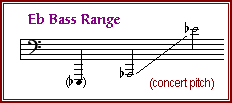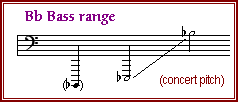
The bass or tuba is the lowest-pitched instrument used in the brass band. Two types are used, the E𝄬 bass and the B𝄬 bass (sometimes referred to as the “double B𝄬 bass”). Tubas are the largest brass instruments, and there are many different patterns and designs in use. The ones most often used in brass bands are in an upright pattern, similar to the euphonium, and have three or four valves of the piston type.
The tubas used in symphony orchestras are most often pitched in F or C. They are also usually upright in pattern, but many are constructed with rotary rather than piston valves. Since orchestral parts are generally written in bass clef, indicating the actual concert pitch to be played, the choice of which tuba to use is often left to the discretion of the player. In marching bands, the helicon or wrap-around tuba (in America, these tubas are commonly referred to as Sousaphones) is often used. These tubas wrap entirely around the player’s body, with a very large flared bell pointing forward. This type of tuba is generally inferior in sound to the upright versions, but is ideal for its intended marching application.
The bore of the typical bass is conical, and the instrument’s sound is on the mellow side. However, because of the depth of the sound, tubas are not regarded as having any particular bright or dark timbre. The tuba is used in almost any combination with the other instruments of the band. The size of the instrument makes it the least agile and responsive of the brass band instruments.
E𝄬 Bass

The E𝄬 bass is pitched a perfect fifth lower than the trombone or euphonium, and an octave lower than the tenor horn. In Salvation Army publications, as in many traditional brass band scores, the bass parts are written in the treble clef, sounding an octave and a sixth below the written (concert) pitch.
The E𝄬 bass is the smaller of the two types of tuba used in the brass band. A full-size brass band has at least two E𝄬 basses, and the part may be written as divisi, frequently in octaves. Although its large size and long main tuba make it less responsive than smaller instruments, it is occasionally used as a solo instrument.
B𝄬 Bass
The B𝄬 bass is the largest and lowest-pitched instrument in the brass band. It is pitched a fourth below the E𝄬 bass, and an octave below the euphonium. In Salvation Army publications, as in many brass band scores, the bass parts are written in the treble clef. The B𝄬 bass sounds two octaves and a second below the written (concert) pitch, which is sometimes credited with the designation of this instrument as the “double B𝄬 bass”.

Role in the Brass Band
As in any musical group, the role of the bass instruments in a brass band is to provide a foundation for the rest of the sound. An essential component of all good brass bands is a powerful bass section, which is sometimes felt rather than heard. In the hands of a skilled player, the bass can be an effective melodic instrument, although solo bass passages are rare.
